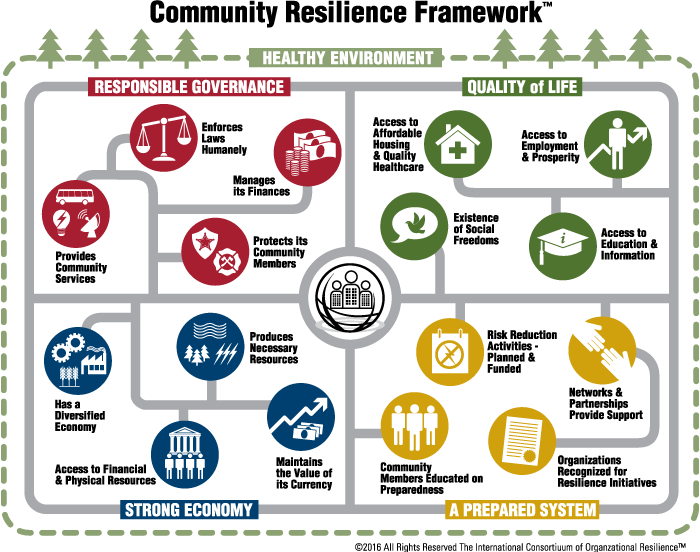
Contact us to donate or share a resource that supports the Community Resilience Framework.
Building Resilient Communities One Organization at a Time
The ICOR Resilient Community Framework asserts that there are five primary systems upon which each community functions no matter its size. Each system contributes to the overall resilience or vulnerability of the community.
When an individual system is strong it creates capital for the community. When an individual system is weak it makes the community vulnerable. The Community Resilience Framework encourages a “systems” view where each system is part of a larger system that works together.
A Healthy Environment
A healthy environmental system:
- Protects and restores the natural resource base upon which life depends.
- Seeks to reduce climate impacts through adaptation and mitigation efforts and increase resource efficiencies.
Responsible Governance
A responsible governance system:
- Provides community services
- Enforces laws humanely
- Protects its community members
- Manages its finances and meets its budgets under changing conditions.
Strong Economy
A strong economic system:
- Produces necessary resources
- Has a diversified economy
- Has access to financial and physical resources
- Maintains the value of its currency
A Prepared System
In a Prepared System:
- Risk reduction activities are planned and funded.
- Networks and partnerships exist to provide support in times of need
- Community members are educated on how to be more prepared
- Organizations within the community are recognized for their resilience initiatives
High Quality of Life
A community with a high quality of life has:
- Access to education & information
- Access to affordable housing & quality healthcare
- The existence of social freedoms
- Access to employment and prosperity.
The quality of the life inside a community directly impacts its resilience. Communities can be vulnerable when there exists internal tensions due to unfairness. In a resilient community, all members of the community are equal and diversity is valued. There exists social freedoms such as freedom of speech and freedom to worship in the religion of their choosing.
A community needs to provide its members with a public education system that provides equal opportunities for the education of all of its community members. Informal education should also be available for community members to access additional learning through traditional and non-traditional methods.
A healthy community includes access to knowledge repositories and information systems such as a library and/or the Internet. This includes the availability of world and community news.
The resilient community places a high value on human life. Community members have access to affordable housing, access to quality and affordable healthcare, and they have the freedom to worship in the religion of their choosing.
A resilient community is one where it is safe for its community members to live.